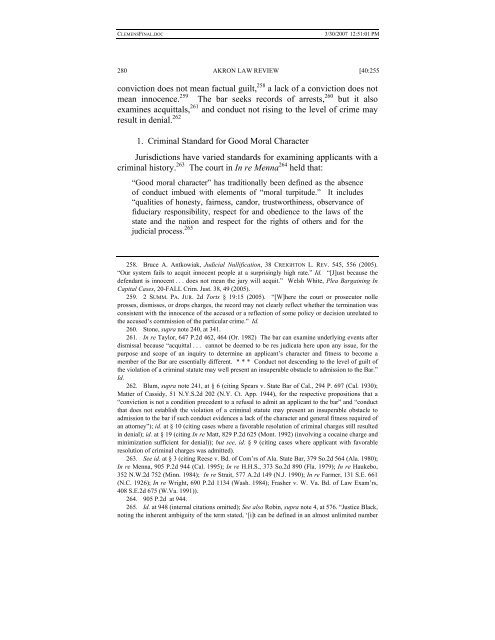Facing the Klieg Lights: Understanding the "Good Moral Character"
Facing the Klieg Lights: Understanding the "Good Moral Character"
Facing the Klieg Lights: Understanding the "Good Moral Character"
Create successful ePaper yourself
Turn your PDF publications into a flip-book with our unique Google optimized e-Paper software.
CLEMENSFINAL.DOC<br />
3/30/2007 12:51:01 PM<br />
280 AKRON LAW REVIEW [40:255<br />
conviction does not mean factual guilt, 258 a lack of a conviction does not<br />
mean innocence. 259 The bar seeks records of arrests, 260 but it also<br />
examines acquittals, 261 and conduct not rising to <strong>the</strong> level of crime may<br />
result in denial. 262<br />
1. Criminal Standard for <strong>Good</strong> <strong>Moral</strong> Character<br />
Jurisdictions have varied standards for examining applicants with a<br />
criminal history. 263 The court in In re Menna 264 held that:<br />
“<strong>Good</strong> moral character” has traditionally been defined as <strong>the</strong> absence<br />
of conduct imbued with elements of “moral turpitude.” It includes<br />
“qualities of honesty, fairness, candor, trustworthiness, observance of<br />
fiduciary responsibility, respect for and obedience to <strong>the</strong> laws of <strong>the</strong><br />
state and <strong>the</strong> nation and respect for <strong>the</strong> rights of o<strong>the</strong>rs and for <strong>the</strong><br />
judicial process. 265<br />
258. Bruce A. Antkowiak, Judicial Nullification, 38 CREIGHTON L. REV. 545, 556 (2005).<br />
“Our system fails to acquit innocent people at a surprisingly high rate.” Id. “[J]ust because <strong>the</strong><br />
defendant is innocent . . . does not mean <strong>the</strong> jury will acquit.” Welsh White, Plea Bargaining In<br />
Capital Cases, 20-FALL Crim. Just. 38, 49 (2005).<br />
259. 2 SUMM. PA. JUR. 2d Torts § 19:15 (2005). “[W]here <strong>the</strong> court or prosecutor nolle<br />
prosses, dismisses, or drops charges, <strong>the</strong> record may not clearly reflect whe<strong>the</strong>r <strong>the</strong> termination was<br />
consistent with <strong>the</strong> innocence of <strong>the</strong> accused or a reflection of some policy or decision unrelated to<br />
<strong>the</strong> accused’s commission of <strong>the</strong> particular crime.” Id.<br />
260. Stone, supra note 240, at 341.<br />
261. In re Taylor, 647 P.2d 462, 464 (Or. 1982) The bar can examine underlying events after<br />
dismissal because “acquittal . . . cannot be deemed to be res judicata here upon any issue, for <strong>the</strong><br />
purpose and scope of an inquiry to determine an applicant’s character and fitness to become a<br />
member of <strong>the</strong> Bar are essentially different. * * * Conduct not descending to <strong>the</strong> level of guilt of<br />
<strong>the</strong> violation of a criminal statute may well present an insuperable obstacle to admission to <strong>the</strong> Bar.”<br />
Id.<br />
262. Blum, supra note 241, at § 6 (citing Spears v. State Bar of Cal., 294 P. 697 (Cal. 1930);<br />
Matter of Cassidy, 51 N.Y.S.2d 202 (N.Y. Ct. App. 1944), for <strong>the</strong> respective propositions that a<br />
“conviction is not a condition precedent to a refusal to admit an applicant to <strong>the</strong> bar” and “conduct<br />
that does not establish <strong>the</strong> violation of a criminal statute may present an insuperable obstacle to<br />
admission to <strong>the</strong> bar if such conduct evidences a lack of <strong>the</strong> character and general fitness required of<br />
an attorney”); id. at § 10 (citing cases where a favorable resolution of criminal charges still resulted<br />
in denial); id. at § 19 (citing In re Matt, 829 P.2d 625 (Mont. 1992) (involving a cocaine charge and<br />
minimization sufficient for denial)); but see, id. § 9 (citing cases where applicant with favorable<br />
resolution of criminal charges was admitted).<br />
263. See id. at § 3 (citing Reese v. Bd. of Com’rs of Ala. State Bar, 379 So.2d 564 (Ala. 1980);<br />
In re Menna, 905 P.2d 944 (Cal. 1995); In re H.H.S., 373 So.2d 890 (Fla. 1979); In re Haukebo,<br />
352 N.W.2d 752 (Minn. 1984); In re Strait, 577 A.2d 149 (N.J. 1990); In re Farmer, 131 S.E. 661<br />
(N.C. 1926); In re Wright, 690 P.2d 1134 (Wash. 1984); Frasher v. W. Va. Bd. of Law Exam’rs,<br />
408 S.E.2d 675 (W.Va. 1991)).<br />
264. 905 P.2d at 944.<br />
265. Id. at 948 (internal citations omitted); See also Robin, supra note 4, at 576. “Justice Black,<br />
noting <strong>the</strong> inherent ambiguity of <strong>the</strong> term stated, ‘[i]t can be defined in an almost unlimited number
















